The Godzilla Reviews - Page 4
After the Japanese film industry went through a massive crash in the mid-70's (as a result of the oil crisis), Godzilla remained in hibernation until 1984, when the franchise underwent its first reboot and entered what is commonly referred to as the Heisei era (or sometimes the "Versus" era). These movies maintain a darker tone than the Showa series is known for by erasing every previous movie with the exception of the original Gojira. While the Heisei series strives to be more serious by keeping Godzilla a villain, it quickly gets carried away by ludicrous plotlines and incomprehensible characters, only redeeming itself with two or three diamonds in the rough.
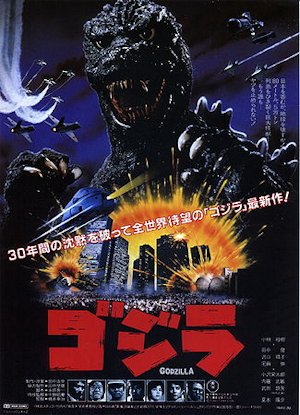 |
RETURN OF GODZILLA
Year: 1984
Era: Heisei
a.k.a. Gojira (1984)
|
 |
RETURN OF GODZILLA
Year: 1984
Era: Heisei
a.k.a. Gojira (1984)
|
THE JIST: It's been thirty years since Godzilla laid waste to Tokyo, and now he has reappeared, bigger and more deadly than ever before. With world leaders urging the prime minister to allow the use of nuclear weapons against the monster, the Japanese must form a plan to stop Godzilla once and for all.
THE VERDICT: This return to Godzilla's roots creates such an effective atmosphere of realism and seriousness that, when the guy in the rubber suit shows up and the military starts firing lasers at him, it is wildly jarring. Still, it serves as proof that the Hollywood model could work, because if you took the exact same script and filmed it with modern big-budget effects, it would be a more successful film. It is genuinely scary, has a well-executed global political story that suits the time period in which it was made, and serves as a nice homage to the original. Alas, it is a little on the slow side. The acting is exceptional, but the music is forgettable, leaving the audience wanting a return to Ifukube's well-known compositions.
GODZILLA 1985
Year: 1985
Era: Heisei
| 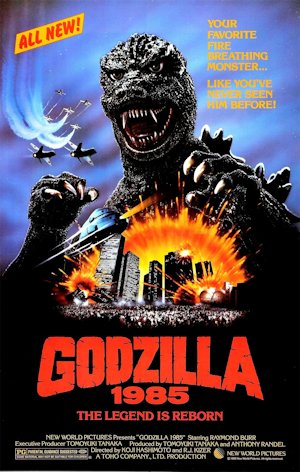 |
 |
GODZILLA 1985
Year: 1985
Era: Heisei
|
THE JIST: The previous year's reboot is brought to American audiences, heavily edited and containing new scenes featuring the return of Raymond Burr's Steven Martin character from Godzilla: King of the Monsters!.
THE VERDICT: This Americanization does a good job trimming the fat and tightening the narrative of the lumbering Return of Godzilla, but it loses some of the weight of the story in the process. The added scenes with Raymond Burr and the Pentagon are utterly pointless and asinine, failing to recapture the magic of the vastly more clever Americanization of Gojira. But most unforgiveable are the anti-Soviet propaganda changes, which are petty and offensive, even considering the fact that the U.S. was still in the middle of the Cold War.
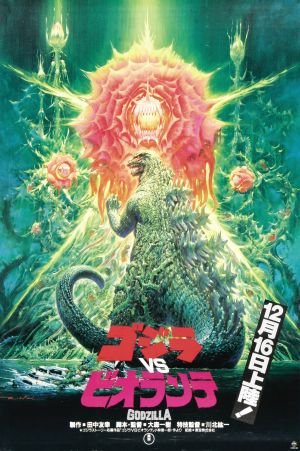 |
GODZILLA VS. BIOLLANTE
Year: 1989
Era: Heisei
|
 |
GODZILLA VS. BIOLLANTE
Year: 1989
Era: Heisei
|
THE JIST: A troubled geneticist splices Godzilla DNA with the combined DNAs of a rose and his dead daughter, creating a monster he dubs Biollante. At the same time, foreign terrorists wake Godzilla and steal the only weapon that might be able to stop him.
THE VERDICT: This movie presents some fresh new ideas and themes and does a good job updating Godzilla for more modern times, but it also introduces the psychic element that will go on to dominate the entire Heisei series. Biollante is one of the most interesting monsters in the Godzilla rogue's gallery, even though it doesn't do a whole lot, and the human characters carry the story well.
GODZILLA VS. KING GHIDORAH
Year: 1991
Era: Heisei
| 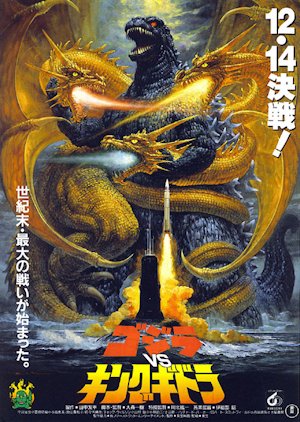 |
 |
GODZILLA VS. KING GHIDORAH
Year: 1991
Era: Heisei
|
THE JIST: Time travelers from the future trick the people of 1992 into eradicating Godzilla from history and creating King Ghidorah, which will destroy Japan to prevent it from becoming a tyrannical corporate superpower in the 21st Century.
THE VERDICT: I know I get extra nitpicky about time travel, but come on! Without getting into too many details, I'll just say that this is one of the worst handlings of time travel in all of science-fiction, and that includes several SyFy Channel originals. Also, why does it completely ignore the fact that the original Godzilla was killed in 1954 (while Return of Godzilla didn't explicitly say whether the original Godzilla was killed by the Oxygen Destroyer in this continuity, Godzilla vs. Destoroyah does)? It's no wonder this is the only Godzilla movie to tackle time travel, since it does it so ridiculously poorly. I mean, why do the Futurians even bother with 1992? How come Mecha King Ghidorah, with all its 23rd Century technology, doesn't have the ability to reflect Godzilla's heat ray, even though humans had already invented it by 1989? Why does everybody in 1992 remember Godzilla after he has been erased from history? I better stop. Even without my anger at having my intelligence insulted by time travel nonsense, this movie completely throws away the potential from Godzilla vs. Biollante and sends the franchise back down the rabbit hole of cheesy sci-fi. There's also some notably bad visual effects concerning the android, M-11, along with some truly terrible acting. The Tokyo scenes are the only things that make this one worth it, but for the most part, this is one of the worst Godzilla movies of them all (and definitely the worst of the Heisei era).
-e. magill 4/22/2014
| MORE LIKE THIS: |
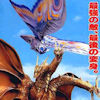
|
The Mothra Reviews
The Geek reviews the original Mothra and the 90's Rebirth of Mothra trilogy, along with 1956's Rodan. [5/30/2019]
|

|
Movie Review: Shin Godzilla
Japan's latest Godzilla film is about as subtle as an earthquake, a tsunami, and a nuclear meltdown, but it is remarkably effective. [8/24/2017]
|
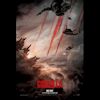
|
Movie Review: Godzilla (2014)
After the long build-up here at emagill.com, it's safe to say my expectations for Godzilla's latest entry were high, and yet they were still exceeded. [6/3/2014]
|
|
|
|
|